

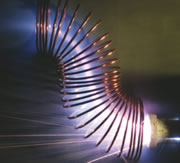
Four of R&D Magazine's prestigious R&D 100 Awards for 2009, which recognize the 100 most significant proven technological advances of the year, have gone to researchers at the Lawrence Berkeley National Laboratory and their colleagues. The 2009 award designees are:
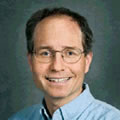 Summer Lecture Series: Talk on Geologic Carbon Sequestration Today
Summer Lecture Series: Talk on Geologic Carbon Sequestration TodayCurtis Oldenburg will speak today on mitigating climate change by injecting CO2 underground. The Summer Lecture Series takes place in the Building 66 auditorium at noon. The remaining lectures in the series will take place July 28 (on gravitational lensing) and August 4 (on personalized cancer treatment). More>
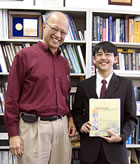 When Javier Fernández-Han was nine years old, he and his family met Ashok Gadgil, a senior scientist in the Environmental Energy Technologies Division who invented UV Waterworks, a simple water-purification system. It turned out to be a momentous occasion for the boy. Six years later, Javier, who is now 15 and lives in Houston, entered "Invent Your World 2009," a contest co-sponsored by the Lemelson Foundation and AshokaTech's Youth Venture. Javier, one of the youngest entrants, took first place, winning a $20,000 scholarship and a trip to a global roundtable on climate change at MIT. His inspiration, he says, came from his meeting with Gadgil. More>
When Javier Fernández-Han was nine years old, he and his family met Ashok Gadgil, a senior scientist in the Environmental Energy Technologies Division who invented UV Waterworks, a simple water-purification system. It turned out to be a momentous occasion for the boy. Six years later, Javier, who is now 15 and lives in Houston, entered "Invent Your World 2009," a contest co-sponsored by the Lemelson Foundation and AshokaTech's Youth Venture. Javier, one of the youngest entrants, took first place, winning a $20,000 scholarship and a trip to a global roundtable on climate change at MIT. His inspiration, he says, came from his meeting with Gadgil. More>
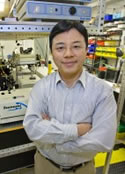 Research: Testing Relativity, Black Holes and Strange Attractors in the Lab
Research: Testing Relativity, Black Holes and Strange Attractors in the LabXiang Zhang, a scientist with the Materials Science Division, led a study in which it was determined that the interactions of light and matter with spacetime, as predicted by general relativity, can be studied using the new breed of artificial optical materials that feature extraordinary abilities to bend light and other forms of electromagnetic radiation. "We propose a link between the newly emerged field of artificial optical materials to that of celestial mechanics, thus opening a new possibility to investigate astronomical phenomena in a table-top laboratory setting," says Zhang. More>
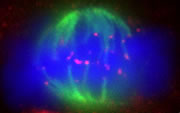 Scientists have a better understanding of what causes an abnormal number of chromosomes in offspring, a condition called aneuploidy that encompasses the most common genetic disorders in humans, such as Down syndrome, and is a leading cause of pregnancy loss. The Berkeley Lab researchers, working with scientists from the University of Tennessee, Knoxville, found that if a mother's egg cell has a mutation in just one copy of a gene, called Bub1, then she is more likely to have fewer offspring that survive to birth. Francesco Marchetti of the Life Sciences Division is co-author of the article that appears in the Proceedings of the National Academy of Sciences. More>
Scientists have a better understanding of what causes an abnormal number of chromosomes in offspring, a condition called aneuploidy that encompasses the most common genetic disorders in humans, such as Down syndrome, and is a leading cause of pregnancy loss. The Berkeley Lab researchers, working with scientists from the University of Tennessee, Knoxville, found that if a mother's egg cell has a mutation in just one copy of a gene, called Bub1, then she is more likely to have fewer offspring that survive to birth. Francesco Marchetti of the Life Sciences Division is co-author of the article that appears in the Proceedings of the National Academy of Sciences. More>
The Women Scientists' Council Luncheon Seminar originally scheduled for today has been rescheduled to August 17. Melissa Lunden, staff scientist for the Atmospheric Sciences Department in the Environmental Energy Technologies Division (EETD), will be the speaker. For details contact Kamala Green at [email protected].
[Orange County Register] Thirty-four Nobel Prize winners sent a letter to President Obama last week, urging him to fulfill his promise of $150 billion in clean energy technology funding. Nobel laureates from USC, UC Santa Barbara, UC Berkeley, Stanford and Berkeley Lab signed the letter, which criticizes the recently passed American Clean Energy and Security Act, saying that the Act does not provide the stable, annual funding that Obama promised earlier this year. More>
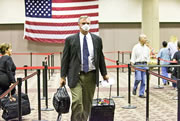 Travel: Possible Delays in International Travel Due to Novel H1N1 Flu Screening
Travel: Possible Delays in International Travel Due to Novel H1N1 Flu ScreeningDue to the outbreak of novel H1N1 flu occurring in the United States and many other countries, airport staff in some countries may check the health of arriving passengers. If you are sick with symptoms of influenza-like illness, you should not travel. Since the novel H1N1 flu outbreak is occurring in the United States, flights from the United States arriving in other countries may be specifically targeted for screening. Travelers coming from the United States may be checked for fever and other symptoms of novel H1N1 flu, and their travel may be delayed. See the CDC website for more information.
Today at Berkeley Lab is produced by Public Affairs' Communications Department